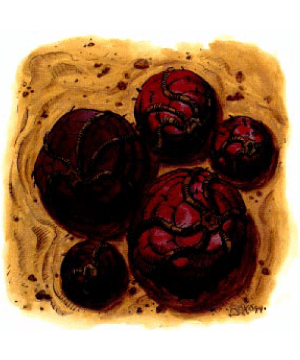

2433

| Climate/Terrain: | Any except forest |
|---|---|
| Frequency: | Uncommon |
| Organization: | Plant |
| Activity Cycle: | Any |
| Diet: | Carnivore |
| Intelligence: | Non- (0) |
| Treasure: | Nil |
| Alignment: | Neutral |
| No. Appearing: | 1-10 (1d10) |
| Armor Class: | 7 |
| Movement: | Special |
| Hit Dice: | 2 |
| THAC0: | 19 |
| No. of Attacks: | 2-5 (1d4+1) |
| Damage/Attack: | 1d3 each |
| Special Attacks: | Impale |
| Special Defenses: | Nil |
| Magic Resistance: | Nil |
| Size: | T (1’ ball) |
| Morale: | N/A |
| XP Value: | 65 |
Rock cacti are small, spherical plants that can be found anywhere water is not plentiful. They are generally brown in color, but deepen to black as they increase their fluid storage. During spring and summer rock cacti produce a bright yellow flower that lasts only a few hours. The rest of the time, rock cacti appear to be roughly spherical rocks, about 1 foot in diameter.
Combat: The preferred method of attack for a rock cactus is to wait until its prey is within a few feet, then quickly extend 2-5 spines. Each spine that hits inflicts 1-3 points of damage. An attack roll of 19 or 20 means the victim has been impaled by a spine for double damage. If a cactus fails to impale, it retracts the spines and fires again the next round.
If a cactus does impale a victim, it retracts the spine, which pulls the plant to its victim. It then drains 1 hp of moisture per round until it is removed, to a maximum of 12 hp. A cactus that is feeding does not attack again until it is dislodged. The excellent camouflage of the rock cactus gives it a +3 on all surprise rolls for the first round of combat.
A rock cactus is interested only in food. If it finds it has attached itself to something more than four times its size, it normally lets go and drops to the ground It continues to fight only in self-defense.
Habitat/Society: Rock cacti are found near game trails in small clumps of as many as 10 plants. They are non-ambulatory and so have no territory. They have been successfully transplanted to the gardens of Tyr, where they keep the rodent population in check.
Rock cacti exude a perfume that is undetectable by demihumans but attracts small rodents and mammals.
Like most plants, rock cacti rely on insects to assist them to reproduce.
Ecology: The rock cactus is at the top of the Plant Life food chain and toward the middle of the animal food chain. It can be peeled and eaten. Each plant produces 1 pound of edible material. The flesh of a rock cactus tastes vaguely like apples and is of similar consistency. As many as 4 pints of fluid can be obtained from a large plant. The plant uses its defense mechanism to stop any casual attempts to eat it.
The plants can be farmed and harvested by holding a bag full of straw in front of them and teasing the plants to attack. The spines are severed before the plants can retract them, making the plants defenseless and easily peeled.
Live rock cacti, for planting in gardens, bring 5 cp each in most markets. A pound of rock cactus flesh is worth l-2 cp, depending on the marketplace it is found in.
Rock Cactus, Bloodsucking
One in 500 rock cacti is a bloodsucking plant, with 3+3 HD. This plant looks the same on the outside as the normal version. Unlike its less deadly cousins, this plant does not release a victim, no matter how large, until it has sucked its fill of blood.
Each tendril that hits absorbs 1 hp of blood each round it is attached. It has a maximum capacity of 100 hp worth of blood, or as much as 10 pints. It swells to allow the fluid to be stored. Once it has attached itself, the bloodsucking cactus does not let go unless all its spines are severed. Spines that break off inside a victim work their way slowly through the victim’s body until they strike a vital organ and cause an agonizing death. These spines may be removed by a cure disease spell or by quickly cutting the spine out.
Bloodsucking rock cacti have no aesthetic or monetary value.

◆ 249 ◆